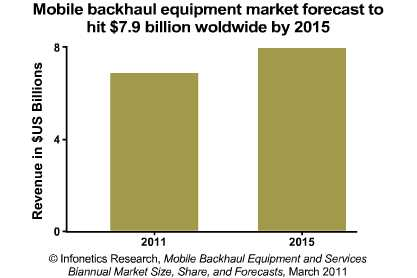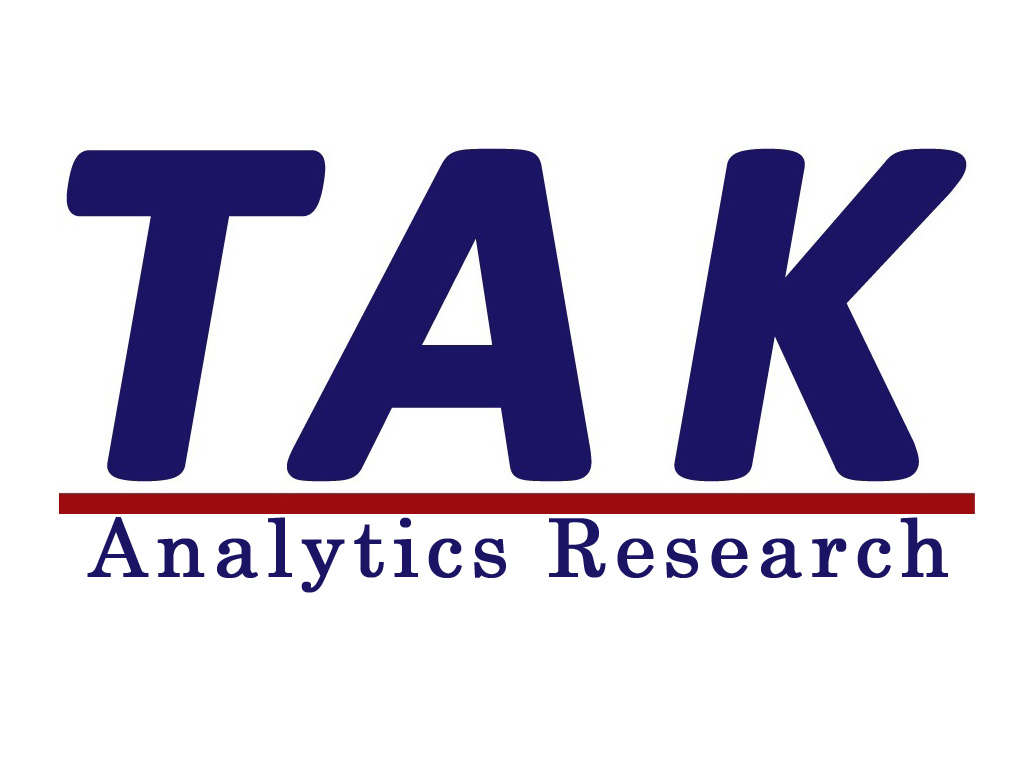Campbell, CALIFORNIA, 2011年4月12日—市場調査会社 Infonetics Researchが先日発表したモバイルバックホール機器およびサービス市場シェアおよび展望に関する報告書は、モバイルバックホール機器の販売業者を市場成長分野とし、モバイルバックホール機器、接続、基地局、サービス料金の分析を行なった。
アナリストノート
「通信オペレータが2Gインフラのリフレッシュ、 3Gネットワークへ移行するにつれ、ほぼ例外なくIP/イーサネットがモバイルバックホールのソリューションとして採用され、3G、LTE, WiMAXネットワークの基幹技術としてIPを使うことによって増大するモバイル・トラフィックの費用を抑制するようになっている。この傾向は増大している: 2010年にモバイルバックホール機器に使われた費用の89%がIP/イーサネット機器に対するもので、とりわけ、イーサネット基地局のルーター、ゲートウェイ、イーサネットパケットマイクロ波機器で急速な成長が見られる。」 これはInfonetics Research の主席アナリストで共同設立者のMichael Howardのコメントである。
Infonetics のマイクロ波関連を統括するアナリストで今回の報告書の作成に参加しているRichard Webbは次のように言っている「無線アクセスネットワークは変化をしており、IP専用基地局、2G、 3G、4G 併用の基地局、密集して配置される小規模基地局への移行は顕著である。マイクロ波関連業者は、新環境に対応し、費用効果や信頼性が高い柔軟な製品をバックホールソリューションとして提供することで収益を増大させている。」

モバイルバックホール機器市場ハイライト
- モバイルバックホール機器市場は全世界で2010年には前年より10.3%成長して$68.4億ドルになった。
- 長期的にイーサネットマイクロ波機器の需要は、マイクロ波の無線イーサネットや小規模な基地局の需要のおかげで好調を維持するが、とりわけハイブリッドTDM/イーサネット機器では単価が徐々に低下するため収益成長は鈍化する。
- 2011年から2015年にかけて、約15億のモバイル加入者および約16億のモバイルブロードバンド加入者が見込まれるため、基地局、基地局間の接続、バックホール容量、各基地局間の接続に必要な機器などをそれぞれ増強する必要がある。
- Ericsson は、モバイルバックホールマイクロ波無線機器の収益シェアを拡大し、この四半期には過去2年間でもっとも高い収益をあげた。
- 2010年の下半期には、 業界1位のAlcatel-LucentそしてTellabs、Cisco、Huaweiを合わせれば、急成長するイーサネット基地局のルーターおよびゲートウェーのセグメントの3/4以上を占めた。
Infoneticsが年2回作成するモバイルバックホール報告では、 世界および地域の市場規模、供給メーカーの市場シェア、2015年までの展望、モバイルバックホール機器 (銅線、光ファイバー、無線)、接続、セルサイト(2G、3G、LTE、 WiMAX、併用)、サービス料金に関する詳細な分析を掲載している。取り扱う技術分野には、PDH、ATM over PDH、SONET/SDH、WDM、イーサネット(銅線、光ファイバー)、DSL、PON、同軸ケーブル、 マイクロ波、TDM、イーサネット、WiMAX、サテライト、IPモバイルバックホール機器がある。本報告では、モバイルバックホールの供給業者や運用者の活動、モバイル運用者の戦略もあつかっている。
本報告書の分析対象となった企業には以下が含まれる: Actelis、Adtran、ADVA、Alcatel-Lucent、Alvarion、ANDA、Aviat、BridgeWave、Cambridge、Celtro、 Ceragon、Ciena、Cisco、DragonWave、ECI, Ericsson-Redback、 Hatteras、 Huawei、 IPITEK、 Juniper、 MRV、 NEC、 Nokia Siemens、 Overture、 RAD Data、Tellabs、 Turin、 ZTE。
(原文)
IP/Ethernet at 89% of all mobile backhaul spending; Ericsson expands microwave lead
Campbell, CALIFORNIA, April 12, 2011—Market research firm Infonetics Research recently released its Mobile Backhaul Equipment and Services market share and forecast report, which ranks mobile backhaul equipment vendors, identifies market growth areas, and provides analysis of mobile backhaul equipment, connections, cell sites, and service charges.
ANALYST NOTE
“As operators refresh their 2G networks and transition to 3G, they almost universally adopt IP/Ethernet as the mobile backhaul solution to lower the costs of growing mobile data traffic, using IP as the base technology for 3G, LTE, and WiMAX networks. And the momentum is growing: 89% of the money spent on mobile backhaul equipment in 2010 was for IP/Ethernet gear, with the fastest growth happening in Ethernet cell site routers and gateways and Ethernet packet microwave equipment,” explains Michael Howard, principal analyst and co-founder of Infonetics Research.
Richard Webb, directing analyst for microwave at Infonetics and contributor to the forecast report, adds: “The radio access network is changing; there is a perceivable transition to IP-centric base stations, co-located 2G, 3G, and 4G base stations, and smaller, more densely deployed base stations. The microwave vendors are responding by broadening their portfolios with products tailored to this new environment, ensuring that microwave stays flexible, cost-effective, and credible as a backhaul solution.”
MOBILE BACKHAUL EQUIPMENT MARKET HIGHLIGHTS
- The mobile backhaul equipment market grew 10.3% in 2010 over the previous year, to $6.84 billion worldwide
- Over the long term, demand for Ethernet microwave equipment will remain healthy, driven by demand for Ethernet-based radios for macro and smaller cell base transceiver stations; however, unit pricing will gradually erode, particularly for hybrid TDM/Ethernet gear, inhibiting revenue growth
- The addition of almost 1.5 billion mobile subscribers and 1.6 billion mobile broadband subscribers between 2011 and 2015 will require more base stations, more cell site connections, higher backhaul capacities, and equipment for each cell site connection
- Ericsson increased its lead in mobile backhaul microwave radio equipment revenue share, posting its best quarter in at least 2 years
- As of the second half of 2010, Alcatel-Lucent widened its #1 lead, and together with Tellabs, Cisco, and Huawei own over 3/4 of the fast-growing Ethernet cell site routers and gateways segment
Infonetics’ biannual Mobile Backhaul report provides worldwide and regional market size, vendor market share, forecasts through 2015, and in-depth analysis for mobile backhaul equipment (copper, fiber, air); connections; installed cell sites (2G, 3G, LTE, WiMAX, mixed), and service charges. Technologies tracked include PDH and ATM over PDH, SONET/SDH and WDM, Ethernet copper and fiber, DSL, PON, coax cable, microwave, TDM, Ethernet, WiMAX, and satellite, with a breakdown of IP mobile backhaul equipment. The report also tracks vendor and operator mobile backhaul activity and mobile operator backhaul strategies. Companies tracked include Actelis, Adtran, ADVA, Alcatel-Lucent, Alvarion, ANDA, Aviat, BridgeWave, Cambridge, Celtro, Ceragon, Ciena, Cisco, DragonWave, ECI, Ericsson-Redback, Hatteras, Huawei, IPITEK, Juniper, MRV, NEC, Nokia Siemens, Overture, RAD Data, Tellabs, Turin, ZTE, and others.

